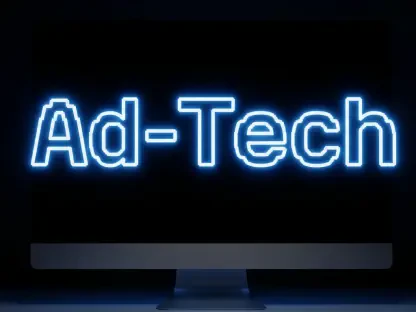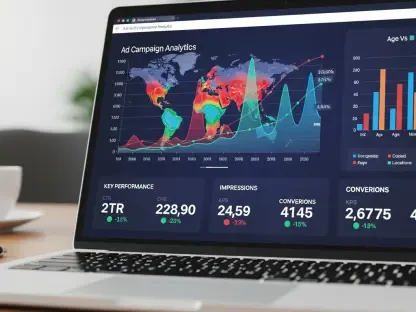In an era where digital landscapes shift at breakneck speed, a staggering 82% of social media marketers are already harnessing artificial intelligence to redefine their strategies for the coming year, marking a pivotal moment for the industry. This statistic underscores how technology and human creativity intersect to capture fleeting consumer attention. As platforms evolve and audience expectations grow, the challenge lies in balancing innovation with authenticity to stand out in a crowded digital space. This report delves into how marketers are leveraging AI and influencer partnerships to craft impactful campaigns, navigating both opportunities and hurdles in their quest for success in 2026.
The Evolving Landscape of Social Media Marketing
The current state of social media marketing reveals a dynamic environment driven by rapid technological advancements and shifting consumer behaviors. According to recent industry insights, marketers are increasingly prioritizing adaptability to keep pace with an ever-changing digital ecosystem. The focus is no longer solely on reach but on creating meaningful connections through tailored content that resonates with diverse audiences across multiple platforms. This shift highlights the urgency for brands to stay ahead of trends while maintaining relevance in a fragmented online world.
Emerging technologies such as AI, alongside the growing prominence of influencer marketing, are reshaping strategic approaches. These tools and tactics enable precise targeting and content personalization, allowing brands to cut through the noise of saturated feeds. Platform diversification further complicates the landscape, as marketers must juggle distinct audience demographics and content styles to maximize impact. Key players, including major platforms like Instagram and LinkedIn, alongside innovative marketers, are setting the tone for this transformation by embracing new ways to engage users.
The importance of adapting to this fluid digital environment cannot be overstated. With consumer preferences evolving alongside technological capabilities, brands that fail to innovate risk losing ground to competitors. The ability to pivot quickly, whether through adopting AI-driven analytics or partnering with trend-savvy influencers, is becoming a cornerstone of effective marketing. As the industry moves toward 2026, staying agile in response to these changes will define the leaders in this competitive space.
Key Trends and Strategies for 2026
Adoption of AI and Influencer Marketing
A significant 82% of marketers are integrating AI into their workflows, utilizing it for analytics, content creation, and ad targeting to streamline operations. This widespread adoption reflects a collective push to enhance efficiency and precision in campaign execution. From generating data-driven insights to automating repetitive tasks, AI is positioned as a critical tool for scaling efforts in an increasingly complex digital arena.
Parallel to this technological surge, influencer marketing is experiencing robust growth, with 67% of marketers planning to increase budgets in this area for 2026. The emphasis lies in boosting brand awareness, particularly through short-form video content that dominates user engagement metrics. Influencers, with their knack for creating relatable material, are becoming indispensable allies for brands aiming to connect authentically with niche audiences.
This trend also signals a broader shift toward authenticity in content creation, as consumers grow wary of overly polished advertisements. Influencers often serve as navigators of platform-specific trends, helping brands craft messages that feel organic rather than forced. By leveraging these partnerships, marketers are finding new pathways to build trust and foster deeper emotional ties with their target demographics.
Platform Diversification and Content Focus
Marketers are increasingly spreading resources across multiple platforms to optimize visibility and referrals, with Instagram leading as the primary focus, followed by LinkedIn and Reddit. This diversification strategy acknowledges that no single channel can fully capture the varied interests of modern audiences. Each platform offers unique strengths, from visual storytelling on Instagram to professional networking on LinkedIn, prompting a nuanced approach to content distribution.
Central to this multi-platform effort is the dominance of short-form video, identified as the most impactful content format for engagement and lead generation goals. The concise, visually engaging nature of such content aligns with shrinking attention spans, making it a priority for campaigns aiming to drive interaction. Growth projections indicate a sustained emphasis on video, with marketers allocating significant resources to refine their output for maximum effect.
To manage the demands of this diversified approach, automation tools are being employed to enhance efficiency across channels. These technologies help mitigate workload challenges, ensuring consistent presence without sacrificing quality. However, marketers must remain cautious of audience overlap and platform-specific nuances, tailoring content to fit distinct user expectations rather than relying solely on cross-posting.
Challenges in Leveraging AI and Multi-Platform Strategies
Despite the enthusiasm surrounding AI, a notable gap exists between its perceived potential and actual impact, with only 35% of marketers reporting significant productivity gains. This discrepancy suggests that while the technology holds promise, its practical benefits are not universally realized. Factors such as limited understanding of AI tools and entrenched resistance to workflow changes contribute to this underwhelming outcome.
Beyond technological hurdles, multi-platform strategies present their own set of obstacles, including the need for highly customized content to suit varied audience preferences. Knowledge gaps in navigating diverse platform algorithms further complicate efforts to maintain relevance across channels. Additionally, the risk of audience fatigue from repetitive messaging underscores the importance of strategic planning in content deployment.
Addressing these challenges requires actionable solutions, such as investing in comprehensive training programs to enhance AI proficiency among teams. Marketers should also approach cross-posting with caution, prioritizing unique content for each platform to preserve engagement. By focusing on education and deliberate content curation, brands can better position themselves to overcome these barriers and harness the full potential of their tools and strategies.
Navigating Compliance and Best Practices
Regulatory considerations are becoming increasingly critical in social media marketing, particularly with data privacy laws shaping how brands collect and utilize consumer information. Platform-specific guidelines for influencer partnerships add another layer of complexity, requiring marketers to ensure transparency in all collaborations. Adhering to these standards is essential to avoid legal repercussions and maintain operational integrity.
The use of AI also brings compliance challenges, as ethical concerns around data handling and algorithmic bias come to the forefront. Transparency in sponsored content, especially in influencer campaigns, remains a priority to uphold consumer trust. Marketers must clearly disclose partnerships and ensure that AI-driven processes align with industry regulations to prevent potential backlash.
Ultimately, adherence to compliance and best practices significantly impacts the credibility of marketing campaigns. Brands that prioritize ethical standards and transparency are more likely to foster long-term loyalty among audiences. Building trust through consistent, lawful practices not only mitigates risks but also enhances reputation in a competitive market.
The Future of Marketing with AI and Influencers
Looking beyond 2026, the trajectory of AI and influencer marketing suggests continued evolution driven by technological advancements and shifting consumer dynamics. AI capabilities are expected to become more sophisticated, potentially unlocking deeper personalization and predictive analytics for hyper-targeted campaigns. Such progress could redefine how brands anticipate and respond to audience needs over time.
New social platforms are also likely to emerge as disruptors, challenging marketers to adapt to unfamiliar environments and user behaviors. Alongside this, consumer preference for authentic, unfiltered content may intensify, further elevating the role of influencers as trusted voices. Brands will need to remain flexible, aligning with creators who embody genuine connection rather than mere visibility.
Global economic conditions and ongoing innovation will undoubtedly influence future strategies, shaping budget allocations and risk tolerance. Marketers must stay attuned to these external factors, balancing investment in cutting-edge tools with the need for sustainable growth. The ability to anticipate and pivot in response to these variables will be a defining factor in achieving enduring success.
Conclusion and Strategic Recommendations
Reflecting on the insights gathered, it becomes evident that the social media marketing landscape has reached a critical juncture where AI adoption, influencer growth, and platform diversification are central to strategic planning. The data underscores both the promise and the limitations of these approaches, painting a picture of an industry in active transition. Marketers have begun to embrace innovation, yet face tangible hurdles in realizing the full scope of their ambitions.
Moving forward, actionable steps emerge as vital for navigating this complex terrain. Setting realistic goals for AI implementation, coupled with robust training programs to bridge knowledge gaps, offers a clear path to maximize technological benefits. Simultaneously, fostering authentic influencer partnerships stands out as a cornerstone for building trust and engagement, urging brands to prioritize quality over quantity in collaborations.
Lastly, a strategic focus on tailored content across platforms promises to mitigate risks of audience overlap and fatigue, ensuring sustained relevance. By investing in these areas—education, authenticity, and customization—marketers can position themselves to not only adapt to upcoming changes but to lead within the evolving digital ecosystem. These considerations provide a roadmap for turning challenges into opportunities, paving the way for impactful growth.









